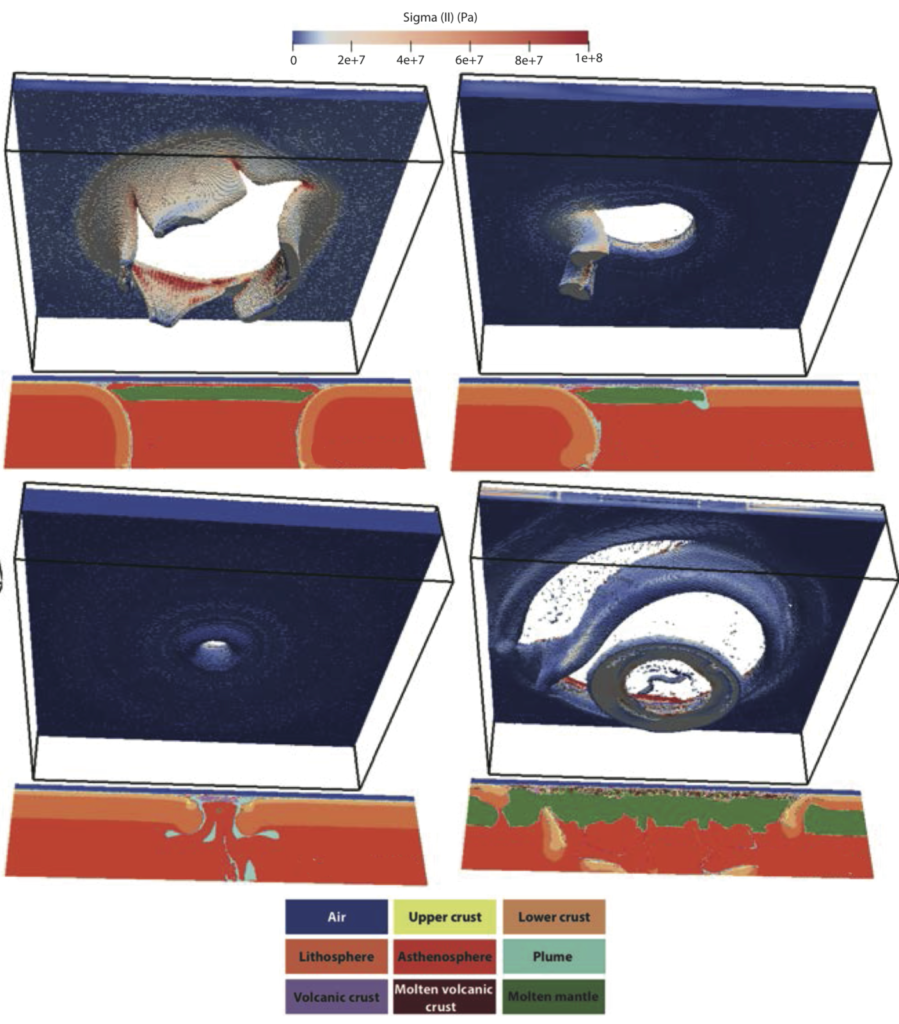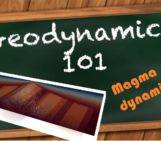

Dr. Marzieh Baes from the Geodynamic Modelling section of GFZ Potsdam, Germany.
This week in News & Views, dr. Marzieh Baes from GFZ Potsdam introduces us to the mechanisms behind subduction initiation. Moreover, she discusses the different types of subduction initiation in reaction to plume-lithosphere interaction that she observed in her recent 3-d numerical modelling study.
Possible scenarios of subduction initiation
According to plate tectonics, oceanic plates are formed at mid-ocean ridges. To preserve the surface of the Earth, heavy and dense plates are consumed and subducted beneath the less dense lithospheres at locations known as subduction zones. Despite several studies having been carried out on subduction zones and their processes, it is still unclear how and where a new subduction zone is formed. To initiate subduction, the lithosphere has to be broken, which is most likely to occur at places of reduced strength, for instance, along a pre‐existing zone of weakness in the lithosphere (McKenzie, 1977). Various tectonic settings can act as pre-existing weaknesses including transform/fracture zones, extinct mid‐ocean ridges or back‐arc regions of mature subduction zones (Fig. 1). Along a transform/fracture zone or a mid‐oceanic ridge, a new subduction zone can form due to a change in the relative plate motion (Hall et al., 2003; Pearce et al., 1992; Uyeda & Ben‐Avraham, 1972). Subduction polarity reversal as a result of buoyant materials such as continental crust or an oceanic plateau entering the subduction system may occur in back-arcs of mature subduction zones (Hathway, 1993; Yan & Kroenke, 1993). Passive margins are other localities that can be potential places for nucleation of subduction (Cloetingh et al., 1982; Nikolaeva et al., 2010). Along these tectonic settings, negative buoyancy of the old oceanic lithosphere along with other processes such as sediment loading (Cloetingh et al., 1982), water weakening (Regenauer-Lieb et al, 2001) and suction forces coming from sinking slabs in the mantle or neighbouring subduction zones (Baes and Sobolev, 2017) can create the necessary driving force to break the lithosphere and initiate a new subduction zone (Fig. 1). Despite lack of any Cenozoic examples of conversion of passive margins into active ones, these tectonic settings are broadly accepted as possible locations of subduction initiation due to the key role that they play in the closing phase of the Wilson cycle (Wilson, 1966).

Figure 1. Schematic illustration of different tectonic settings proposed as the possible localities of subduction initiation. The description above the arrows indicates the main cause of conversion of these different tectonic settings into subduction zones.
Another proposed scenario is plume‐induced subduction initiation (Baes et al., 2016, 2020; Gerya et al., 2015; Ueda et al., 2008; Fig. 1). Contrary to passive margins and pre‐existing weakness zones in the lithosphere which are products of plate tectonics, plume-induced subduction initiation is independent of any pre-conditions related to plate tectonics. Therefore, it can address the challenging question of “How did the first subduction zone on Earth form?”. Based on this scenario, when a mantle plume reaches the bottom of a plate it may break the lithosphere. An oceanic plateau forms above the plume head as a result of decompression melting of the plume material. Uprising of plume rocks atop of the broken segments of the lithosphere forces the plate to descend into the mantle and eventually results in subduction initiation. Subduction nucleation in the Caribbean region at ~100 Ma (Whattam & Stern, 2014) and formation of the Cascadia subduction zone in Eocene times (Stern & Dumitru, 2019) were recently suggested as the first and second natural example of plume‐induced subduction initiation.
Plume-induced subduction initiation
Previous studies on subduction initiation induced by plume-lithosphere interaction noted that the newly formed slab usually has a cylindrical shape (Gerya et al., 2015; Baes et al., 2016). Ring confinement, which acts as a resistive force, may be overcome by tearing of the slab, resulting in multi-slab subduction (Gerya et al., 2015). In our recent study (Baes et al., 2020), we aimed to investigate the conditions leading to formation of a single-slab subduction zone, which is a common feature of the modern Earth. Our 3-d numerical modelling results showed four distinct lithospheric regimes: (a) Multi-slab subduction initiation, (b) single-slab subduction initiation (c) no subduction initiation and (d) episodic short-lived circular subduction initiation (Fig. 2). Age of the oceanic lithosphere, thickness of the crust, extension rate, and mantle temperature are the controlling parameters of these different lithospheric responses. On modern Earth, plume-lithosphere interaction can lead to aforementioned deformation regimes, except for episodic short-lived circular subduction initiation, which never occurs on the present-day Earth.

Figure 2. Four different lithospheric responses to plume-lithosphere interaction: top left) multi-slab subduction; top right) single-slab subduction; bottom left) no subduction initiation; and bottom right) episodic short-lived circular subduction initiation.. The upper panels show the second invariant of the stress tensor in the lithospheric part of the numerical models. The lower panels illustrate the compositional field of a cross-section cutting through the middle of the model (see colour legend at the bottom of the figure).
A multi-slab subduction zone is initiated if a plume interacts with a relatively young oceanic lithosphere (<30 My, but older than 10 My). Single-slab subduction forms when the lithosphere has a moderate age of 30-50 My. Subduction cannot be initiated when the lithosphere is old (>50 My). However, extension facilitates the subduction initiation process, enabling formation of new subduction zones within older lithospheres. Arrival of a plume beneath a lithosphere containing a thick plateau can lead to subduction initiation only if the lithosphere is subjected to extension.
In Archean times, when the mantle was hotter and crust was thicker than at present day, plume‐lithosphere interaction could result in formation of either multi‐slab subduction zones or episodic short‐lived circular subductions. In contrast to the present day, in early Earth interaction of a plume with an old oceanic lithosphere (>40 My) could lead to formation of a multi-slab subduction. When the plume reached a younger lithosphere however, the response would be episodic short-lived circular subduction initiation. These results also show that contrary to present day, where formation of a subduction zone induced by plume-plateau interaction is unlikely, plume‐induced subduction initiation in the hot early Earth with a thick crust was quite possible.
Based on our numerical modelling results, we propose that single‐slab subduction in the Caribbean region was initiated when a plume arrived either beneath a plateau which was under extension, or beneath a lithosphere with a typical crustal thickness of 8 km. Lithospheric extension ~100 Ma in Caribbean could be related to the extensional regime in the back‐arc region of the west dipping Puerto Rico/Lesser Antilles subduction zone. We note that it is not clear whether plume‐lithosphere interaction in the Caribbean occurred within the pre‐existing plateau or away from it. Further study is needed to investigate the effect of non‐uniform crustal thickness and the relative location of plume head and the oceanic crust/plateau border on the subduction initiation process.
Yes, plume-lithosphere interaction can initiate a modern subduction zone!
Editor’s note: Interest piqued? Have a look at this Geodynamics 101 post on subduction and subduction initiation.
References Baes, M., Sobolev, S.V., Gerya, T., & Brune, S. (2020). Plume‐Induced Subduction Initiation: Single‐Slab or Multi‐Slab Subduction? Geochemistry Geophys. Geosystems, 21, doi:10.1029/2019GC008663. Baes, M., & Sobolev, S.V. (2017). Mantle Flow as a Trigger for Subduction Initiation: A Missing Element of the Wilson Cycle Concept. Geochemistry Geophys. Geosystems, 18, 12, 4469-4486. Baes, M., Gerya, T. V., & Sobolev, S. V. (2016). 3‐D thermo‐mechanical modeling of plume‐induced subduction initiation. Earth Planet. Sci. Lett., 453, 193–203. Cloetingh, S. A. P. L., Wortel, M. J. R., & Vlaar, N. J. (1982). Evolution of passive continental margins and initiation of subduction zones. Nature, 297, 139–142. Gerya, T. V., Stern, R. J., Baes, M., Sobolev, S. V., & Whattam, S. A. (2015). Plume‐induced subduction initiation triggered Plate Tectonics on Earth. Nature, 527(7577), 221–225. Hall, C. E., Gurnis, M., Sdrolias, M., Lavier, L. L., & Muller, R. D. (2003). Catastrophic initiation of subduction following forced convergence across fracture zones. Earth Planet. Sci. Lett., 212, 15–30. Hathway, W. B. (1993). The Nadi Basin: Neogene strike‐slip faulting and sedimentation in a fragmented arc, western Viti Levu, Fiji. J. Geol. Soc. London, 150, 563– 581. McKenzie, D. P. (1977). Initiation of trenches: A finite amplitude instability. In M. Talwani, & W. Pitman (Eds.), Island Arcs, Deep Sea Trenches and Back‐Arc basins, Maurice Ewing Series, (Vol. 1, pp. 57–62). Washington, D. C.: American Geophysical Union. Nikolaeva, K., Gerya, T. V., & Marque, F. O. (2010). Subduction initiation at passive margins: Numerical modeling. J. Geophys. Res., 115, B03406. https://doi.org/10.1029/2009JB006549 Pearce, J. A., van der Laan, S. R., Arculus, R. J., Murton, B. J., Ishii, T., Peate, D. W., & Parkinson, I. J. (1992). Boninite and harzburgite from Leg 125 (Bonin‐Mariana Forearc): A case study of magma genesis during the initial stages of subduction. In L. B. Stokking (Ed.), Proc.Ocean Drill. Prog., Sci. Results (Vol. 125, pp. 623–659). College Station, TX: Ocean Drilling Program. https://doi.org/10.2973/odp.proc.sr.125.172.1992 Regenauer‐Lieb, K., Yuen, D. A., & Branlund, J. (2001). The initiation of subduction: Criticality by addition of water? Science, 19, 578–580. Stern, R. J., & Dumitru, T. A. (2019). Eocene initiation of the Cascadia subduction zone: A second example of plume‐induced subduction initiation? Geosphere, 15, 659–681. Ueda, K., Gerya, T. V., & Sobolev, S. V. (2008). Subduction initiation by thermal–chemical plumes: Numerical studies. Phys. Earth Planet. Inter., 171(1), 296–312. Uyeda, S., & Ben‐Avraham, Z. (1972). Origin and development of the Philippine Sea. Nature, 240, 176–178. Whattam, S. A., & Stern, R. J. (2014). Late Cretaceous plume‐induced subduction initiation along the southern margin of the Caribbean and NW South America: The first documented example with implications for the onset of plate tectonics. Gondwana Research, 27. https://doi.org/10.1016/j.gr.2014.07.011. Wilson, J. T. (1966). Did the Atlantic close and then re‐open? Nature, 211, 676–681. Yan, C. Y., & Kroenke, L. W. (1993). A plate‐tectonic reconstruction of the southwest Pacific, 100‐0 Ma. Ocean Drilling Program Proceedings, Scientific Results, 130, 697–710.



